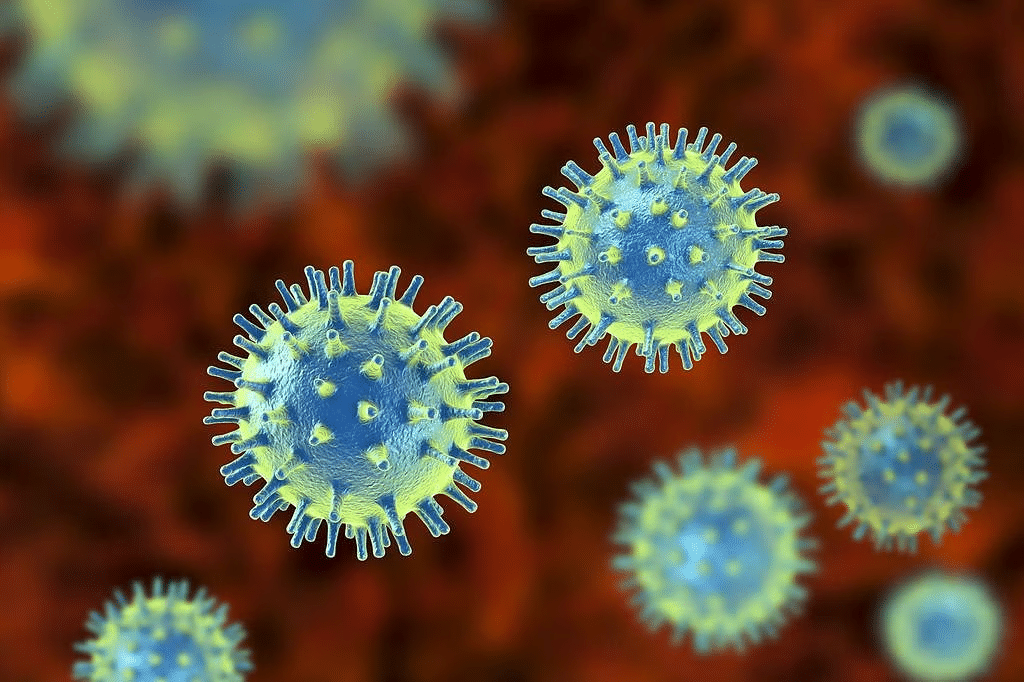Very Short Answers - Microorganisms: Friend and Foe | Science Class 8 PDF Download
Q 1: What are microorganisms or microbes?
Ans. The organisms which are not seen with our naked eyes are called microorganisms.
Q 2: Give two examples of microorganisms.
Ans. Bacteria and Fungi.
Q 3: What are the four major groups of microorganisms?
Ans.
(i) Bacteria
(ii) Fungi
(iii) Protozoa
(iv) Algae
Q 4: What are viruses?
Ans. Very tiny microscopic organisms that reproduce only inside the cells of host organisms are called viruses.
 Virus
Virus
Q 5: Write the names of some diseases caused by viruses.
Ans. Influenza (Flu), Polio and Chicken Pox are some diseases caused by viruses.
Q 6: Name some diseases caused by Protozoans.
Ans. Dysentery and Malaria.
Q 7: Mention some diseases caused by bacteria.
Ans. Typhoid and Tuberculosis (TB) are the bacterial diseases.
Q 8: Name two single-celled microorganisms.
Ans. (i) Bacteria (ii) Some algae.
Q 9: Name two multicellular microorganisms.
Ans. (i) Fungi (ii) Algae.
Q 10: What are the two types of microorganisms on the basis of their functions?
Ans. (i) Useful microorganisms. (ii) Harmful microorganisms.
Q 11: Name the microorganisms which promote the formation of curd.
Ans. Bacterium Lactobacillus promotes the formation of curd.
Q 12: What is the main ingredient of rava idlis and bhaturas?
Ans. Curd.
Q 13: Mention two groups of microorganisms that live in colonies.
Ans. (i) Bacteria (ii) Fungi
Q 14: What is fermentation?
Ans. The process of conversion of sugar into alcohol is known as fermentation.
Q 15: Name the scientist who discovered fermentation.
Ans. Louis Pasteur discovered fermentation in 1857.
Q 16: What are antibiotics?
Ans. The medicines which kill or stop the growth of the disease‑causing microorganisms are called antibiotics.
Q 17: Who discovered antibiotics?
Ans. Alexander Fleming in 1929.
Q 18: Name some antibiotics.
Ans. Streptomycin, Tetracycline, and Erythromycin are some antibiotics.
Q 19: What do you mean by the antibodies?
Ans. When a disease-carrying microbe enters the body, the body produces a substance to fight the invader, these are called antibodies.
Q 20: What is a vaccine?
Ans. The medicine used to protect children from several diseases is called a vaccine.
Q 21: What do you mean by vaccination?
Ans. The process of providing vaccines is called vaccination.
Q 22: Name a popular vaccination program.
Ans. Pulse Polio Programme.
Q 23: Who discovered the vaccine for smallpox?
Ans. Edward Jenner in 1798.
Q 24: What do you mean by nitrogen fixation?
Ans. The process by which atmospheric nitrogen is converted into nitrates by the action of microorganisms is called nitrogen fixation.
Q 25: What are pathogens?
Ans. The disease‑causing microorganisms are called pathogens.
Q 26: How do pathogens enter our body?
Ans. The pathogens enter our body through air, water and food.
Q 27: Name two communicable diseases.
Ans. Cholera and Chicken Pox.
Q 28: What are carriers of disease-causing microbes?
Ans. The insects and animals that help in the transmission of the pathogens from the source to the persons are called carriers of disease‑causing microbes.
Q 29: Which is the carrier of dengue virus?
Ans. Female Aedes mosquito.
Q 30: Why should we not let water collect anywhere?
Ans. All mosquitoes breed in water. Hence we should not let water collect anywhere.
Q 31: Name a disease that is common in humans and other animals.
Ans. Anthrax.
Q 32: Name the pathogen of anthrax.
Ans. Bacillus anthracis.
Q 33: Write the name of the viral disease in cattle.
Ans. Foot and Mouth disease.
Q 34: What do you mean by food preservation?
Ans. The process to prevent food material from spoilage by the action of microbes is called preservation.
Q 35: What are preservatives?
Ans. The chemicals which are used to check the growth of microorganisms are called preservatives.
Q 36: Name some preservatives.
Ans. Sugar, salt, oils, and vinegar are some common preservatives.
Q 37: Which microorganisms are called nitrogen-fixing bacteria?
Ans. Rhizobium bacteria.
Q 38: Where do Rhizobium bacteria commonly live?
Ans. Rhizobium bacteria live in the root nodules of leguminous plants
Q 39: What do you mean by symbiotic relationship?
Ans. The relationship between two organisms in which both organisms benefit is called a symbiotic relationship.
Q 40: Mention the amount of nitrogen gas in the atmosphere.
Ans. 78%
|
90 videos|296 docs|44 tests
|
FAQs on Very Short Answers - Microorganisms: Friend and Foe - Science Class 8
| 1. How do microorganisms benefit humans? |  |
| 2. Can all microorganisms cause disease? |  |
| 3. How can we prevent the spread of harmful microorganisms? |  |
| 4. What are some examples of beneficial microorganisms? |  |
| 5. How do microorganisms contribute to the environment? |  |

















